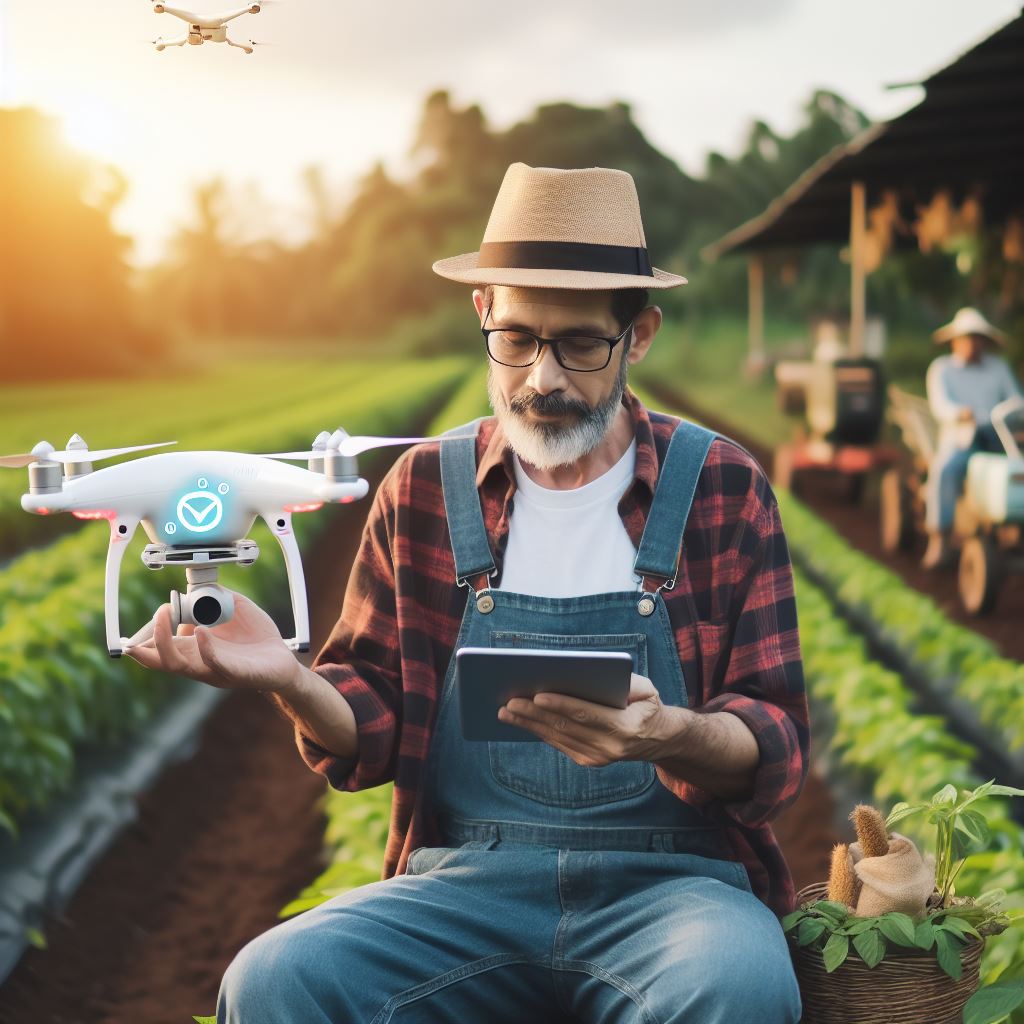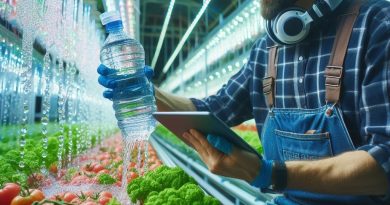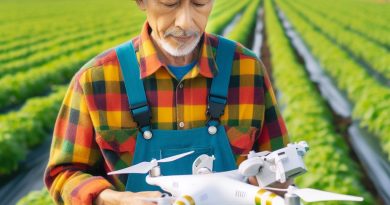Next-Gen Farming: The Role of Drones
Last Updated on February 15, 2024
Introduction
In recent years, farming has experienced a dramatic transformation thanks to the advancements in technology.
The traditional methods are slowly giving way to next-generation farming techniques that leverage cutting-edge tools to maximize productivity.
One such technological innovation making waves in the agricultural sector is drones.
These unmanned aerial vehicles have catapulted farming into a new era of precision and efficiency.
Drones offer a multitude of benefits to the agricultural industry.
With their ability to capture aerial images and data, they provide farmers with valuable insights into crop health, water usage, and soil conditions.
This information allows farmers to make informed decisions, optimizing their farming practices to achieve higher yields and reduce resource wastage.
The use of drones in agriculture also eliminates the need for manual labor in certain tasks.
They can be programmed to autonomously perform tasks such as seeding, spraying pesticides, and monitoring livestock, saving farmers both time and effort.
Additionally, drones can cover large areas of farmland quickly and efficiently, enabling farmers to identify problem areas and respond promptly to prevent crop loss.
Furthermore, drones contribute to sustainable farming practices by reducing the reliance on chemicals.
With their precise spraying capabilities, drones can target specific areas in need of treatment, reducing the overall use of pesticides and fertilizers.
This not only minimizes environmental impact but also cuts costs for farmers.
In essence, drones are revolutionizing the agricultural sector by significantly enhancing productivity and sustainability.
Their ability to capture data, automate tasks, and optimize resource usage has made them indispensable tools for modern farmers.
As technology continues to evolve, drones will undoubtedly play an even larger role in shaping the future of farming.
Benefits of using drones in farming
Agricultural drones have revolutionized the farming industry, providing numerous benefits that have transformed the way crops are grown and monitored.
Here are some key advantages:
Increased efficiency and productivity
- Drones enable farmers to cover large areas quickly, saving time and labor.
- They can survey fields and identify areas that require attention, ensuring no resources are wasted.
- With drones, farmers can analyze crop health and growth patterns, allowing for targeted interventions.
- The ability to program drones means they can operate autonomously, eliminating the need for constant human supervision.
- Drones equipped with advanced imaging technology provide real-time data, optimizing decision-making processes.
Cost reduction and improved profitability
- Farmers can monitor their crops more effectively, leading to reduced expenses in fertilizer, water, and pesticides.
- With precise data on crop health, farmers can react quickly to any issues, minimizing crop loss and maximizing yields.
- Eliminating the need for manual labor in certain tasks can significantly decrease operational costs.
- Efficient resource management through drone use allows farmers to make informed decisions, increasing profitability.
- Drones can also assist in the maintenance of machinery and infrastructure, preventing costly breakdowns.
Precision agriculture and crop monitoring
- Drones equipped with multispectral or thermal sensors can provide valuable insights into crop health and development.
- These sensors can detect variations in plant health, identify diseases, and optimize irrigation and fertilizer application.
- Precision agriculture techniques enabled by drones improve pesticide targeting, minimizing environmental impact.
- Real-time aerial imagery and data collection allow for immediate problem identification, reducing crop damage.
- Continuous crop monitoring through regular drone flights ensures the early detection of potential issues.
In summary, the benefits of using drones in farming are undeniable.
Enhanced efficiency, cost reduction, improved profitability, precision agriculture, and crop monitoring are just a few advantages that drones bring to the industry.
As technology advances, drones will certainly continue to play an increasingly significant role in next-gen farming.
Read: Drone Imaging in Farms: A New Perspective
Applications of drones in agriculture
Crop spraying and fertilization
- Drones are revolutionizing the way farmers spray pesticides and fertilizers on their crops.
- With precise navigation systems, drones can spray chemicals evenly and accurately, reducing wastage.
- This method also ensures that farmers are not exposed to the harmful chemicals used in traditional spraying methods.
- The ability of drones to fly low and cover large areas quickly makes crop spraying more efficient and cost-effective.
Planting and seeding
- Drones can precisely plant seeds and seedlings, saving significant time and effort for farmers.
- With advanced imaging systems, drones can identify the optimal spots to plant seeds, ensuring proper distribution.
- This technology allows for faster and more effective reforestation efforts, helping to combat deforestation.
- Additionally, drones can also deliver nutrients to young plants, promoting their growth and development.
Livestock monitoring
- Drones equipped with thermal imaging cameras can monitor livestock, ensuring their well-being in large-scale farms.
- Farmers can easily identify any abnormalities, such as injuries or sickness, from an aerial view.
- Real-time data gathered by drones can help farmers make informed decisions related to the health and management of their livestock.
- This technology minimizes manual labor and provides a more comprehensive and efficient solution for monitoring animals.
Crop health assessment and disease detection
- Drones equipped with multispectral cameras can monitor crop health by capturing images that reveal plant stress.
- These images can detect early signs of pest infestations, nutrient deficiencies, or diseases, allowing farmers to take immediate action.
- By identifying problem areas, drones can help farmers apply targeted treatments, reducing unnecessary pesticide use.
- With the ability to cover large areas quickly, drones enable farmers to survey their crops more frequently, improving yields and minimizing losses.
In general, the applications of drones in agriculture have the potential to transform the industry.
By leveraging the capabilities of drones, farmers can enhance their spraying and fertilization methods, streamline planting and seeding processes, improve livestock monitoring, and assess crop health more effectively.
These advancements not only increase efficiency but also promote sustainable farming practices by reducing the use of chemicals and optimizing resource allocation.
As technology continues to advance, drones will continue to play a crucial role in next-gen farming, enabling farmers to achieve higher productivity and ensure food security for a growing population.
Read: Farming Apps: Top Picks for 2024
Challenges and Considerations
Regulatory constraints and legal issues
- Drones for farming face regulatory constraints as laws vary across different countries and regions.
- Privacy concerns arise as drones can capture data and images that might infringe on individuals’ privacy.
- Proper permits and licenses may be required for drone operation, adding complexity and costs.
Technological limitations and barriers to adoption
- Limited battery life restricts the amount of time drones can be used for monitoring crops.
- Weather conditions, such as strong winds or rainfall, can impact the flight stability and operation of drones.
- Initial investment in drone technology may be expensive and might discourage some farmers from adopting them.
Data management and privacy concerns
- Collecting and managing the vast amount of data generated by drones can be challenging for farmers.
- Ensuring the security and privacy of this data, especially when it contains sensitive information, is crucial.
- Integrating drone data with existing farm management systems can be complex and require technical expertise.
In a nutshell, while drones offer significant potential for revolutionizing farming practices, various challenges and considerations must be addressed for their successful integration.
Regulatory constraints and legal issues, technological limitations, and data management and privacy concerns are some of the primary factors that need attention.
Farmers, governments, and technology providers should collaborate to establish clear regulations, minimize technological limitations, and implement robust data management practices.
By doing so, the role of drones in next-gen farming can be maximized, leading to improved efficiency, productivity, and sustainability in the agricultural sector.
Read: Farm Data Analysis: Improving Yields

Success stories and case studies
Examples of farmers utilizing drones effectively
John, a soybean farmer from Kansas, integrated drone technology into his operations, surveying fields more frequently and accurately.
With drones, he identified early signs of pest infestations and nutrient deficiencies, increasing crop yield by 20%.
Sarah, a vineyard owner in California, utilized drones with thermal cameras to monitor grapevines.
She detected diseases early, implementing targeted treatments and irrigation adjustments, resulting in improved grape quantity and quality.
Michael, a wheat farmer in Iowa, employed drones to identify areas affected by weed growth.
He precisely targeted herbicide applications, reducing chemical usage and reallocating resources to essential tasks.
Lisa, a dairy farmer in Wisconsin, used drones equipped with thermal cameras and GPS tracking.
She closely monitored cow movement and health, ensuring timely assistance and improved livestock well-being.
Positive outcomes and tangible benefits achieved
- Reduced costs: Farmers saw a significant decrease in expenses related to manual labor and equipment maintenance.
- Increased efficiency: Drones enabled farmers to cover larger areas of land in a shorter amount of time.
- Improved accuracy: The aerial perspective provided by drones allowed farmers to identify specific problem areas and take targeted action.
- Enhanced crop management: Drones provided valuable data on crop health, allowing farmers to make informed decisions regarding irrigation and fertilization.
- Minimized environmental impact: Farmers reduced chemical usage by targeting specific areas, benefiting the environment and consumer health.
- Enhanced livestock management: Drones assisted farmers in monitoring the health and behavior of their animals, leading to better overall welfare.
Future trends and developments
Advancements in drone technology for farming
- Drones equipped with advanced sensors can monitor crop health, detect pests, and assess soil conditions.
- Improved battery life and flight time allow drones to cover larger areas and gather more data.
- The use of high-resolution cameras enables detailed imaging for precise analysis of crop growth.
Integration of artificial intelligence and automation
- Artificial intelligence algorithms can process data collected by drones to provide real-time insights.
- Drones can be programmed to autonomously perform tasks such as crop monitoring, irrigation, and fertilization.
- AI-based software can analyze data patterns and suggest optimal farming strategies for maximizing yield.
Potential impact on food security and sustainability
- Drones can help farmers identify stressed areas in their fields, leading to targeted interventions and resource optimization.
- Early detection of diseases or pests allows for prompt action, reducing crop loss and ensuring food security.
- Precision application of fertilizers and pesticides minimizes environmental impact and promotes sustainable practices.
- The use of drones in agriculture facilitates efficient water management and reduces water wastage.
- Automation and AI integration reduces the need for manual labor, making farming less labor-intensive and more cost-effective.
- Remote monitoring through drones can enable farmers to access real-time data and make informed decisions.
- Drones have the potential to revolutionize farming practices, making them more efficient, productive, and sustainable.
- The availability of affordable drone technology can empower small-scale farmers in developing countries.
- Greater efficiency and productivity in farming can contribute to global food security by meeting growing demands.
- Drones can play a vital role in sustainable farming practices, promoting biodiversity and preserving ecosystems.
- The data collected by drones can be integrated with other technologies like precision agriculture for optimized resource management.
- Advanced analytics can help farmers anticipate challenges and adapt their farming strategies accordingly.
In closing, advancements in drone technology, the integration of AI and automation, and their potential impact on food security and sustainability are key future trends in next-generation farming.
The use of drones in agriculture can revolutionize farming practices by providing real-time data, optimizing resource management, and making farming more efficient and productive.
It is crucial to leverage these developments to ensure global food security, promote sustainable practices, and empower farmers worldwide.
Read: Nano-Tech in Farming: Small but Mighty
Conclusion
Drones have proven to be game-changers in next-gen farming.
Their importance cannot be overstated, as they have revolutionized the way farmers approach various tasks.
From crop monitoring and spraying to livestock management, drones have significantly increased efficiency and productivity in the agricultural industry.
Moreover, their ability to collect and analyze real-time data has allowed farmers to make informed decisions, leading to reduced costs and better resource management.
The transformative potential of this technology is remarkable.
As drone capabilities continue to advance, they will further revolutionize the field of agriculture.
With the ability to scan large areas quickly and accurately, drones can help identify crop diseases and monitor plant health, enabling farmers to take preventive measures and optimize crop yield.
Additionally, with advancements in artificial intelligence and machine learning, drones can even autonomously perform tasks like crop planting and harvesting, further reducing labor costs and increasing productivity.
Furthermore, drone technology has the potential to make farming more sustainable.
By precisely targeting pesticide and fertilizer applications, drones can minimize their usage, thereby reducing environmental pollution.
Additionally, monitoring soil moisture levels and irrigation needs can help optimize water usage, a critical resource for agriculture.
All in all, drones are revolutionizing next-gen farming by improving efficiency, productivity, and sustainability.
As this technology continues to evolve, its transformative potential will bring immense benefits to farmers and the agricultural industry as a whole.
Embracing and harnessing drone technology is essential for a bright and sustainable future of farming.


